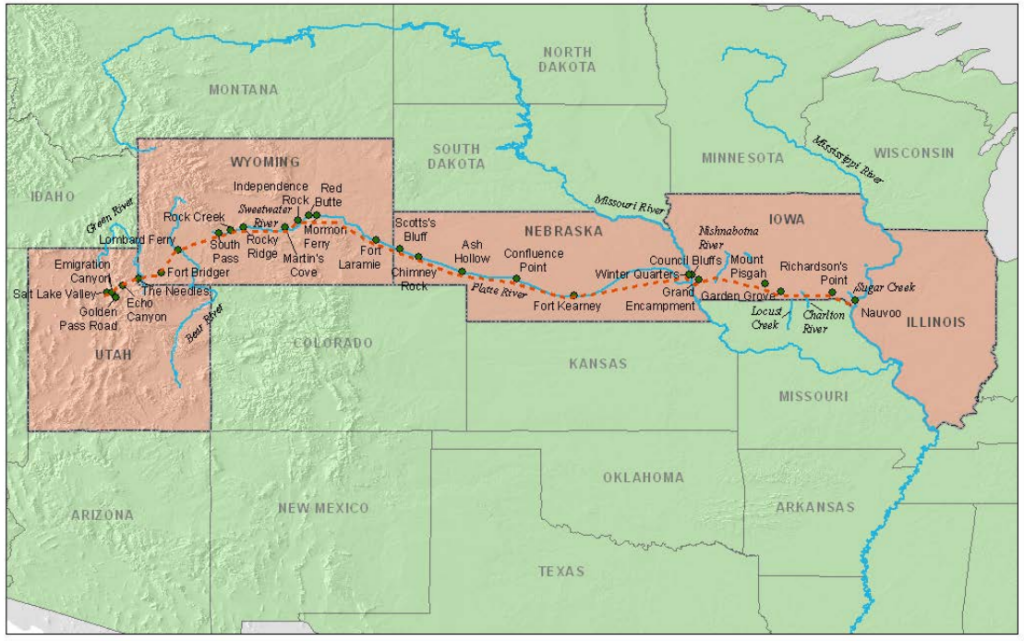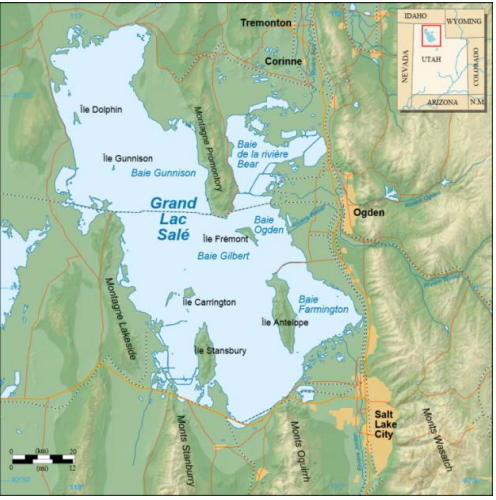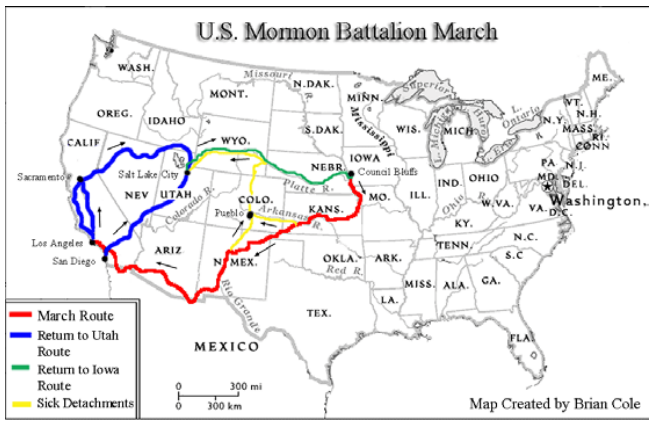Section #10 - A Manifest Destiny craze results in the Texas Annexation and a victorious war with Mexico
Chapter 129: The Mormons Find Their Home And Support The War
July 24, 1847
The Mormons Arrive At Their “New Jerusalem” In Salt Lake City

While the U.S. Army marches toward Mexico City, followers of the Church of Jesus Christ of Latter Day Saints, or Mormons, are on their way toward their “New Jerusalem” home in Salt Lake City.
Their journey has been marked by a long string of setbacks.
After being driven out of their home base in Missouri in 1839 for the practice of polygamy, they settle in Illinois, at the city of Nauvoo, on the banks of the Mississippi River, roughly 200 miles upstream from St. Louis. But here too local attacks on members of the sect soon materialize. Then on June 27, 1844, their charismatic leader, Joseph Smith, and his brother Hyrum are murdered while under arrest for ordering an attack on an opposition newspaper in town.
Many assume that Smith’s death will mark the end of the sect, among them The New York Herald, which writes:
The death of the modern mahomet (Mohammed) will seal the fate of Mormonism. They cannot get another Joe Smith. The holy city must tumble into ruins, and the ‘latter-day saints’ have indeed come to the latter day.
With Smith gone, the Mormons are indeed shaken, and deeply divided over the choice of a successor. When the main body settles in 1845 on Brigham Young, one of the Twelve Apostles, several splinter groups depart from Nauvoo and scatter to new sites. Young too recognizes the need to abandon the town and looks to the west in search of a permanent home.
In February of 1846 he leads an initial contingent of 4,000 of the faithful out of Nauvoo. They struggle across the frozen Mississippi some 300 miles to Council Bluffs, Iowa, where they set up winter quarters.
In the spring of 1847, a small group resumes what will become another laborious three month journey. Accompanying Young here are 143 men, three women and two boys, traveling in 72 wagons. As they set out, they are accompanied by some 93 horses, 66 oxen, 52 mules, 19 cows, 17 dogs and a batch of chickens.
Their path takes them due west along the Oregon Trail, the well-known and well-traveled route mapped in 1842 by the John Fremont expedition – whose records Young relies on to guide his way.
The Mormons pass through Ft. Kearney and Ft. Laramie and, after the usual hard uphill climb, Young crosses the Rockies at the “South Pass,” veering south from there to Ft. Bridger and down through Echo Canyon.

On July 22, 1847 an advance contingent emerges from the Wasatch Mountains and gazes upon a valley southwest of the 2,000 square mile Great Salt Lake — the sixth largest lake in America, with salinity levels far in excess of ocean water. They set up camp and await the arrival of Young himself, who lags behind due to illness.
Two days later when Young arrives, several members of the party urge him to continue on to California – but he demurs, saying simply:
It is enough. This is the right place.
Land for the Mormon’s Salt Lake Temple and the adjoining Tabernacle is dedicated within days, and the settlers begin to lays out their city grid, build homes, plant crops and begin their new lives.
They will be soon be joined by thousands of others who hope to finally practice their religion in peace.
In December 1847, Brigham Young – “prophet, seer, and revelator to the world” — becomes the Second President of the Church (succeeding Joseph Smith), an office he will hold until his death in 1877.
At long last, the Church of the Latter Day Saints have found their new leader and their permanent home.
July 1846-47
A Mormon Brigade Supports The War With Mexico

During their stay in Illinois, the Mormons have consistently supported the Democratic Party, including both Stephen Douglas and James Polk.
In 1845, Brigham Young writes to Polk, asking for government protection of his followers. Polk expresses his support for the Mormons, including a small personal donation of $10 to their cause.
From that time on, Young looks for a way to repay the debt, and the opportunity arises as they trek toward Utah during the early days of the War with Mexico.
Polk desperately needs additional troops to prosecute the war, especially in the far west.
In 1846, he asks Young to assemble a 500 man force to support the fight, to demonstrate the sect’s loyalty to the United States and, in turn, to dampen public opposition to their religious beliefs.
Thus the “Mormon Battalion,” roughly 550 men strong, is mustered into the U.S. Army in July 1846, and sent on the longest overland military march in history, southwest through Kansas, New Mexico, and Arizona to their destination at Los Angeles.
However, like most troops in the northern theater, the Mormon Battalion sees no actual combat.
After their one year-long enlistment expires; many Mormons stay on in California. One of them, a man named Henry Bigler, ends up in January 1847 on a sawmill construction project near Ft. Sutter – where he earns lasting fame, along with Jim Marshall, as the first to discover gold along the American River. Over time, a total of $17,000 will be contributed to the Mormon cause by Brigade members who participate in the subsequent 1849 gold rush.
In the end, the Battalion’s efforts have served Young’s ends, establishing goodwill with Polk and the public, and also providing funds — from the $30,000 total pay the unit receives for its year of service — to purchase livestock, wagons and supplies needed for the upcoming trek to find a new home.